When it comes to reptiles of the UK, most people think of the two most famous: the grass snake (Natrix Helvetica) and the adder (Vipera Berus). But, did you know there are six species of native terrestrial reptile, three snake species and three types of lizard?
Reptiles are usually (and sadly) forgotten when it comes to UK wildlife, which is a shame for these interesting and increasingly rare British inhabitants. This article will shine a light on these wonderful creatures, and help you identify them, if you are lucky enough to see them in the wild.
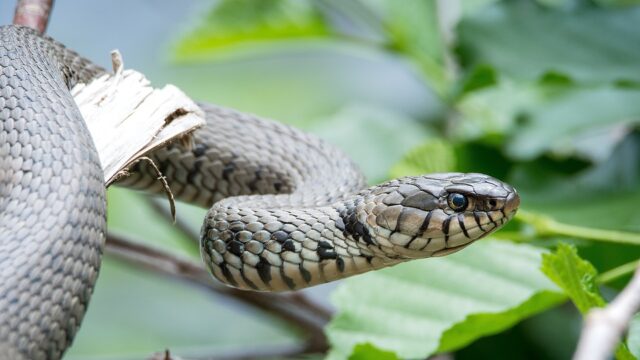
Additionally, there are five known sea turtles that have been found occasionally off British waters, these are the Leatherback, Green, Hawksbill, Loggerhead and Kemps Ridley, all of which are rare sightings. However, land reptiles of the UK is the focus for this article.
Let’s go through these six native species in more detail:
Native UK Snakes
Common European Adder (Vipera Berus)
Adders are the most most common snake seen in the UK, and the most northerly of the viper family. They are found across the UK from the south coast of England, right up to the top of Scotland (with the exceptions of The Isle of Man, Northern Ireland, Scilly isles and the Channel islands). They are usually found in woodland edges, heathland and moorland, sandy heaths and meadows, typically on free draining soils where plenty of sunlight hits the ground.
Adders rarely enter gardens unlike grass snakes that can sometimes found around garden ponds. Sadly, in recent years the adder has declined (and could be absent) from many midland counties. They are predominately diurnal (daytime active), though have been known to be active in the evening and night in southern summer months.
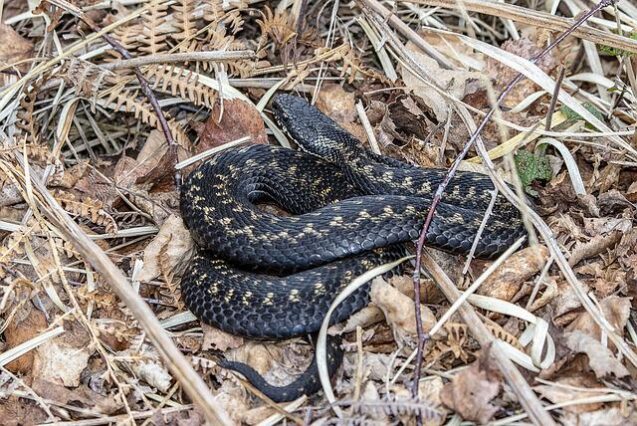
Identifying Adders
- Adders are small stocky snakes, up to 60cm for males and up to 80cm for females
- Adders have a wide flat head (like many Vipers) with a dark X or V shaped marking to the back of the head.
- Large red eyes.
- A distinctive, continuous (though sometimes incomplete) zig-zag pattern down its back to its tail, with dark longitudinal spots alongside this on both sides. The background colour is grey-white in males (with blacker zig-zag) and various shades of brown to copper (with dark brown zig-zag) in females.
- There can also be black (melanistic) adders in some areas which causes the markings to disappear, these tend to be more likely females.
- Young adders can be copper or reddish browns.
The Adder is the UK’s only venomous snake. Although potentially serious, adder bites to humans or dogs are rarely fatal. Reports show there have been only ten fatal bites from these snakes in the last 100 years in the UK, and no-one has died in the last 20 years either.
Bites tend to occur when snakes are harassed or deliberately disturbed, or when stepped on or picked up. Adders are secretive and usually prefer to hold still or move away from human presence. The bites are painful and can cause issues for the very young, ill or old, so medical attention for adder bites should be sought immediately for precautionary reasons.
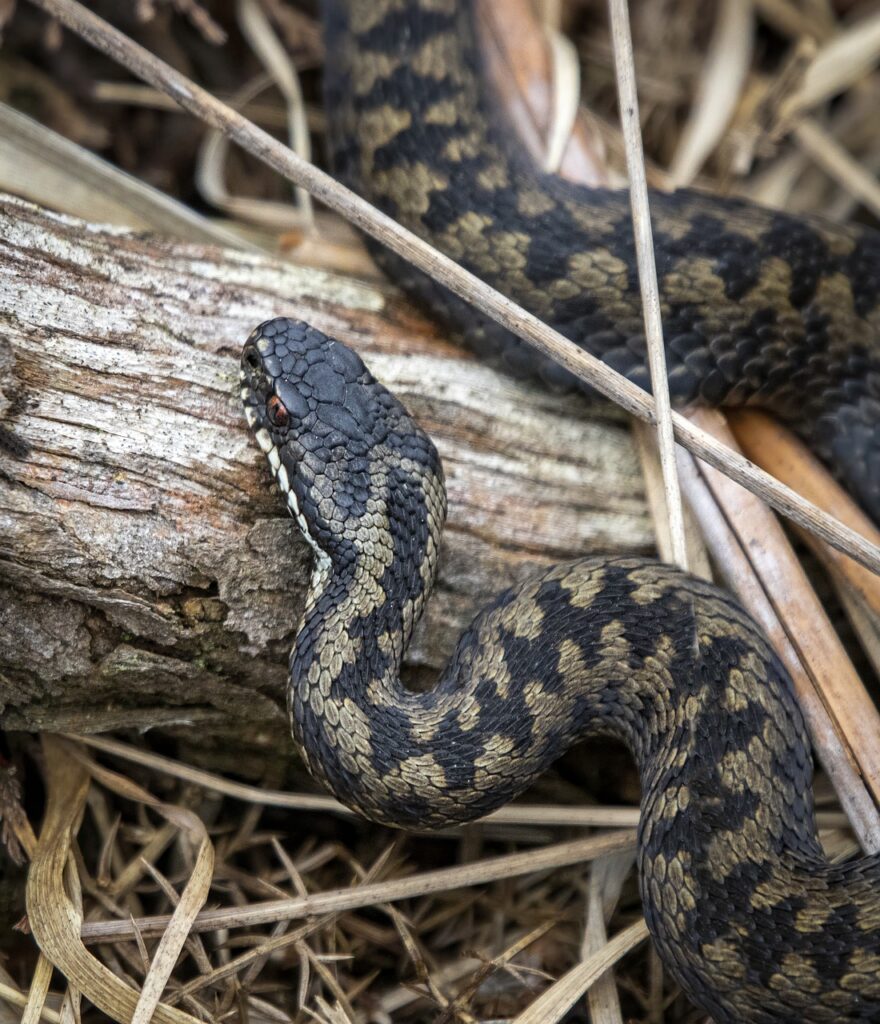
What do Adders Eat?
The adder’s venom is used to subdue its prey, which are small mammals (mice, voles, rats and shrews), lizards, amphibians and birds. Unlike the other two constrictor type snakes in this guide, adders have also been observed using the tip of their tail as a lure to resemble a caterpillar or worm to attract birds.
Adders strike their prey swiftly, inject their venom and then withdraw, saving themselves from the potential bites and damage of holding onto their prey. They then consume the food whole, usually after locating the head end and not going against the fur.
It’s a popular thought that snakes dislocate their jaws, but rather they have elastic ligaments that allows the wider gape, making it easy to consume larger prey than what would otherwise fit.
Adder Hibernation and Breeding
Adders hibernate and emerge very early in the year, some as early as late January before sunning themselves on south-facing slopes.
They mate in late spring to early summer, with the young arriving in August/September. Female adders are ovoviviparous, meaning they incubate the eggs internally before giving birth to live young. They can typically have 3-20 babies in a clutch, the babies are between 14-23cm at birth and born with venom ready to use.
Adders have a lifespan of approximately 15-20 years. They are protected in the UK from being killed, injured or traded and are in serious declining numbers across the UK.
Barred Grass Snake (Natrix Helvetica)
The grass snake is the UK’s largest snake, and in 2017 discovered to be a separate species from the European variety (Natrix Natrix). It is now known as the Barred Grass Snake. It is a non-venomous constrictor, found throughout England and Wales and rarely into the very south of Scotland.
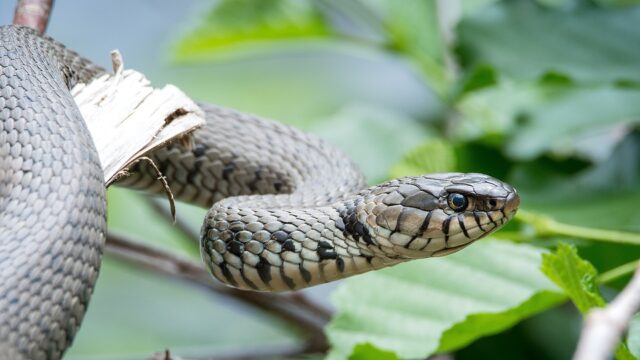
Grass snakes are strong swimmers and are usually found close to fresh water. They are found in wetland, heathland, moorland and at certain times of year, dry grassland. They are commonly seen in gardens, especially ones with ponds.
When approached, grass snakes tend to move off quickly, but if cornered they can feign death, turning themselves over and gaping their mouth with their tongues exposed. If picked up they can release a foul smelling musk that once smelt wont be forgotten! Occasionally, certain individuals can be more defensive, hissing and striking with a closed mouth. They can also flatten their heads to mimic a venomous snake, hoping to be left alone.
Grass snakes are predated by herons and other bird species as well as foxes, weasels, hedgehogs as well as domestic cats.
Identifying Grass Snakes
- Grass snakes are a long slender snake, reaching a length of up to 150cm long, the females being the larger of the two
- Grass snakes are green (from grey/green through olive to darker greens) in colour with black bars along their sides. Their barred name comes from their most distinctive feature, the yellow and black collar around their necks.
Grass snakes, because of their size and neck markings, are a very easy snake to identify. They don’t have such a great variation in colouring and markings like the adder.
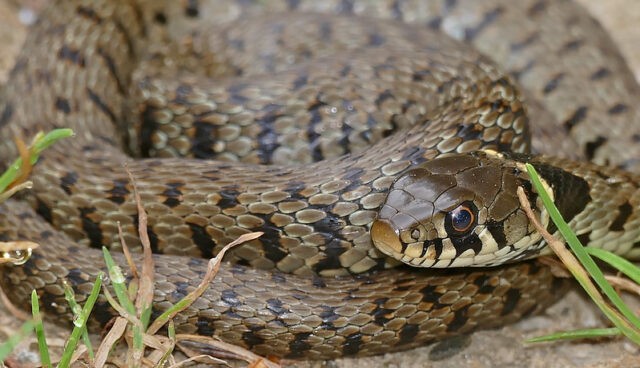
What do Grass Snakes Eat?
The Grass snakes diet consists of a wide range of amphibians, fish and small mammals (though these are more of a rarity. They sometimes eat larvae and earthworms too. Being semi-aquatic, their primary foods are amphibians like common toads and frogs.
Grass Snake Hibernation and Breeding
Grass snakes emerge from hibernation around May or April, after sheltering underground. Males tend to emerge first, beginning to bask to increase metabolism and get themselves ready for the emergence of females a couple of weeks later.
The mating usually happens around April time, before the females lay between 8-40 leathery eggs between June and July.
Grass snakes are the UK’s only egg laying native snakes, opting for rotting vegetation like compost heaps. The young snakes are approximately 15-18cm long, and independent miniature versions of their parents from birth.
Grass snakes have a lifespan of approximately 25 years, and are Protected in the UK from being killed, injured or traded.
Smooth Snake (coronella austriaca)
The smooth snake is the UK’s rarest snake, limited to small areas in Southern England. The snake gets its name from the fact it hasn’t got keeled scales that both the adder and grass snakes have, so it feels smooth to the touch.

Smooth snakes favour sunny, sandy heathland, and like a similar habitat and locations as the sand lizard. They can be found in Dorset, Hampshire and Surrey, with re-introductions in Devon and West Sussex.
Smooth snakes tend to bask under debris exposed to the sun, rather than basking in the open, again making them a rarer to spot species. They are predated by similar species that prey on grass snakes, such as foxes, badgers, weasels, as well as domesticated cats.
Identifying Smooth Snakes
- Smooth snakes are the most slender of the three snakes, ranging in length from 50-70cm in length. Females at the larger end to the males.
- The colourings are grey to dull brown with a pair of dark dot markings longitudinally along their backs.
- Their head has a dark brown heart shaping crown covering the back of the head, (giving the Coronella latin name), as well as a dark eye stripe from near their snout, to their eyes.
- Eyes have round pupils, unlike adders.
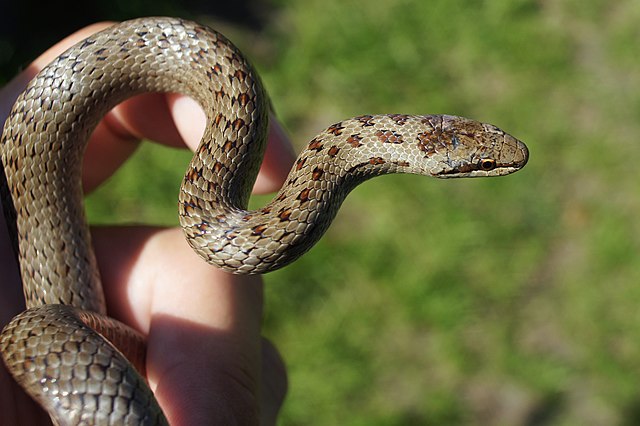
What do Smooth Snakes Eat?
Smooth snakes are non venomous. Their diets consists of common lizards, slow worms as well as small mammals like shrews. They grip the prey in their mouths, and use their coils to subdue, rather than fully constrict, like some species of snake.
Smooth Snake Hibernation and Breeding
Smooth snakes emerge from hibernation in May-April. Mating takes place soon after in April-May and like adders, they are ovoviviparous, meaning they incubate the eggs internally before giving birth to live young. They give birth to 4-15 young in September ,which are independent, fully active versions of their parents. The females tend not to breed every year, making each breeding even more critical to this rare and endangered species.
Smooth snakes have a lifespan of up to 20 years, and are protected in the UK from being killed, injured or traded.
Native UK Lizards
Slow Worm (anguis fragilis)
Slow worms are a legless lizard that is commonly misidentified as a snake. Interestingly, the latin name Anguis fragilis means fragile snake! Unlike snakes, slow worms have eyelids, ear openings and the ability to drop their tails when threatened or grabbed. The tail regrows, though as in many species, the regrown tail always seems more obvious.
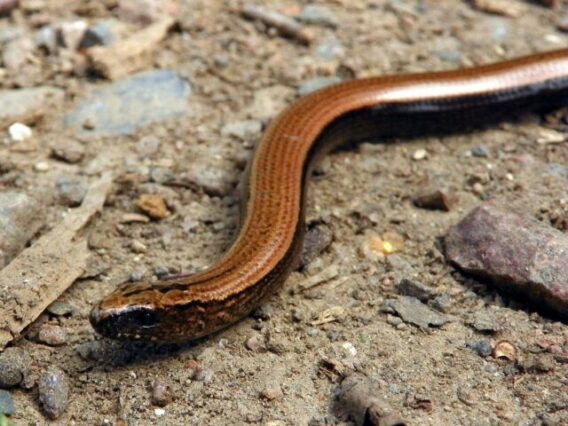
Slow worms are found throughout the UK, with the exception of Northern Ireland, Scottish Islands and a few of the Channel Islands). The live in moorlands, grasslands, heathland and woods, but can be found in gardens and allotments too.
Slow worms rarely bask in the open, preferring to bask partially hidden. They are preyed on by adders, foxes, badgers, hedgehogs and domestic cats. If you have a cat, it will be less likely for you to spot slow worms in your garden. Slow worms are mostly active in the evening and night.
Identifying Slow Worms
- Slow worms have eyelids and ear openings, unlike snakes.
- They have a very shiny appearance, males are a greyish brown, with females a medium brown with dark sides. Occasionally females can have a dark line longitudinally along their backs, both have a greyish blue belly.
- Slow worms can grow up to 50cm in length.
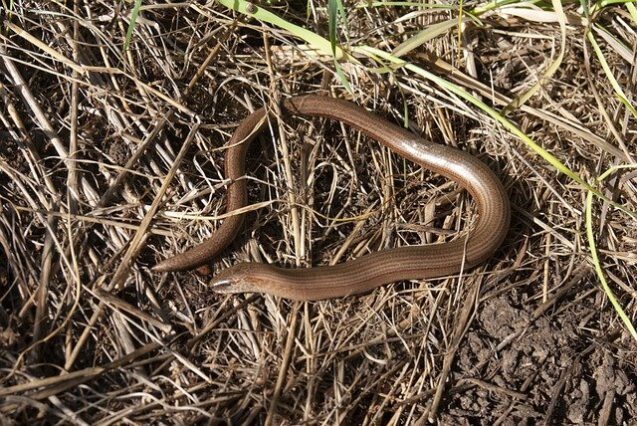
What do Slow Worms Eat?
Slow worm’s food is made up of slugs, snails or slow moving invertebrates. For gardeners, it’s a welcomed remover of pests!
Slow Worm Hibernation and Breeding
Adults emerge from hibernation in March, with breeding taking place in April/May.
Females incubate internally as others mentioned (ovoviviparous), before giving birth to 8-12 live young in late summer. The young, fully-formed slow worms are 7-10cm long and have a golden yellow back and black sides. They are decreasing rapidly in numbers in recent decades.
The lifespan for slow worms is approximately up to 30 years, and one slow worm in captivity lived to 54 years. Slow worms are protected in the UK from being killed, injured or traded.
Common Lizard (zootoca vivipara)
The common, or viviparous, lizard is the UK’s most common reptile. It is found throughout the UK, except Channel Islands, Scilly Isles and Scottish Islands, and the only reptile found in Ireland. It is frequently seen on moorlands, embankments, dry stone walls, cliff tops and grasslands, basking in sunny spots.
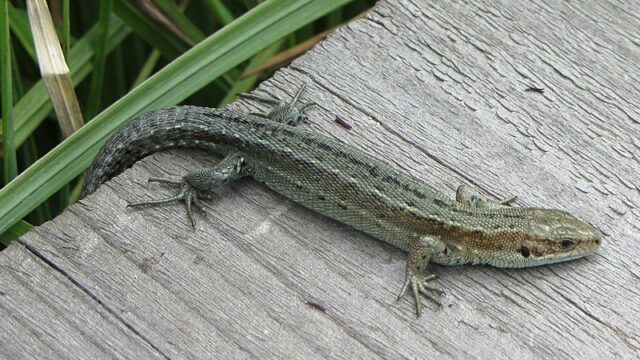
Common lizards are mainly predated by birds of prey, crows and magpies, as well as domestic cats. Like slow worms, common lizards have the ability to drop their tales when threatened or grabbed.
Identifying Common Lizards
- Common lizard colour is usually a dull brown with a pattern of dark longitudinal stripes and spots, but can be yellowish, greenish or even black in some individuals.
- Females have pale unspotted belly’s, the males white, yellow or muddy red with black spots.
- They can grow up to 15cm in length, from nose to their tail.
What do Common Lizards Eat?
The common lizard’s diet consists of predominately spiders and insects, which they tend to shake violently before consuming. They are totally carnivorous compared to sand lizards.
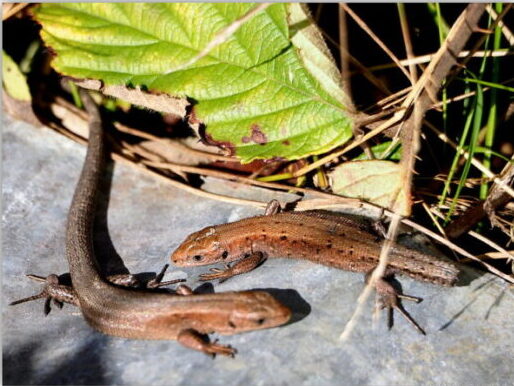
Common Lizard Hibernation and Breeding
Common lizards emerge from hibernation in early spring, before mating in around April. Females birth live babies in late July to August, to between 4-11 young, which are around 4-5cm long. Like most others in this article, common lizards are in decline in recent years.
Common lizards have a lifespan of approximately 6 years, and protected in the UK from being killed, injured or traded.
Sand Lizard (lacerta agilis)
Sand lizards are one of the UK’s rarest reptiles, only be found in small pockets in England and Wales. They live on sandy heathlands in Dorset, Hampshire and Surrey, and the protected Merseyside dune system.

They have also been and reintroduced into other areas of the south-east, south-west, Lancashire and Wales, but because sand lizards need specific undisturbed sand to lay their eggs, it limits their range even within those areas.
Habitat loss is the sand lizard’s biggest threat in recent years, especially with their narrow and specific needs. Housing and agriculture being the most obvious, with heath fires adding more pressures to their delicate lives.
Sand Lizards are predated by foxes, badgers, birds of prey as well as domesticated cats.
Identifying Sand Lizards
- Sand lizards are stocky large lizards (larger than common lizards). They grow up to 20cm in length (snout to tail tip) with males being slightly larger.
- Females are sandy brown with a brown blotched pattern longitudinally down their backs, with a pair of strong dorsal stripes. Males have the same brown back pattern, but with bright green flanks (from snout to tail) that are at their brightest during breeding.
- Like both slow worms and common lizards, sand lizards also have the ability to shed their tail when threatened or caught.
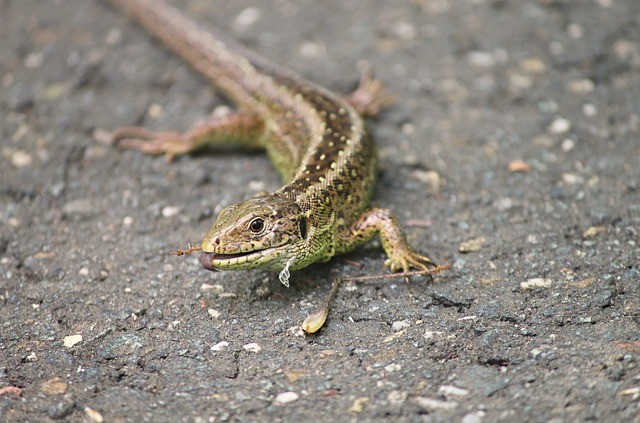
What do Sand Lizards Eat?
Sand lizards diet consists of slugs, spiders, and insects, as well as some fruit and vegetable matter.
Sand Lizard Hibernation and Breeding
Sand lizards emerge from hibernation March or early April, and mating takes place in April/May.
Unlike common lizards, sand lizards lay eggs rather than live births. One clutch of 6-15 eggs are laid in undisturbed sand in May or early June, getting warmth from the sun before hatching 6cm babies in August or September. These babies, like all the reptiles mentioned, are ready to survive straight from birth.
Sand lizards have a lifespan of up to 12 years, and are protected in the UK from being killed, injured or traded.
The UK is home to some amazing reptiles. Hopefully, you will be lucky enough to see one on your next ramble outside!

